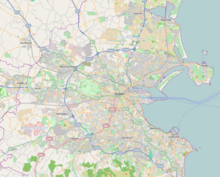Newbridge Avenue
 The New Bridge crossing the Dodder | |
| Native name | Ascaill an Droichid Nua Error {{native name checker}}: parameter value is malformed (help) |
|---|---|
| Former name(s) | Haig's Lane, New Bridge Avenue[1] |
| Namesake | The new stone bridge over the River Dodder |
| Length | 290 m (950 ft) |
| Width | 15.3 metres (50 ft) |
| Location | Sandymount, Dublin, Ireland |
| Postal code | D04 |
| Coordinates | 53°20′07″N 6°13′25″W / 53.335365°N 6.22368°W |
| northeast end | Tritonville Road |
| southwest end | Lansdowne Road, Herbert Road |
| Other | |
| Known for | Ulysses |
Newbridge Avenue (Irish: Ascaill an Droichid Nua) is a road in the Sandymount district of Dublin which links Herbert Road and Tritonville Road.
In the novel Ulysses, the funeral of the character Paddy Dignam starts here at number 9 and continues on to Glasnevin Cemetery via Tritonville Road.[2][3] The Dignams were said to live at number 9; the property was, in reality, vacant in 1904.[4]
Both this road and Herbert Road were built across land which once belonged to Haigs' distillery and so it used to be called Haig's Lane; the foundations of the Avenue were constructed with stone which originally came from the Dodderbank Distillery.[5] The distillery fields at this location featured in the sensational murder of the Reverend George Wogan in 1826.[6] A new stone bridge replaced the old wooden toll bridge in the mid-19th century, giving the road the name of "New Bridge Avenue."[1] Construction of houses upon this land then took place in the 1860s.[7]
Due to the Irish property bubble of recent times, properties in this road have risen greatly in value and, in 2006, a house was sold for €2M.[8]
See also
References
- ^ a b Meyler, Walter Thomas (March 10, 1868). "Saint Catherine's bells: : an autobiography". London : Simpkin, Marshall, and Co. ; Dublin: : Robert S. M'Gee, 35 Lower Sackville Street; and all booksellers – via Internet Archive.
- ^ Don Gifford, Robert J. Seidman (1989), Ulysses Annotated, p. 105, ISBN 978-0-520-06745-5
- ^ Clive Hart, Leo Knuth (1975), A Topographical Guide to James Joyce's Ulysses
- ^ Robert Martin Adams (1962), Surface and Symbol, Oxford University Press, p. 61
- ^ Douglas Bennett (1991), Encyclopaedia of Dublin, p. 145, ISBN 978-0-7171-1599-0
- ^ Weston St. John Joyce, Patrick Weston Joyce (1913), The Neighbourhood of Dublin: Its Topography, Antiquities and Historical Associations
- ^ Tom Kennedy (1980), Victorian Dublin
- ^ Donnybrook five-bed makes €3.66 million, Irish Times, 3 Mar 2006

